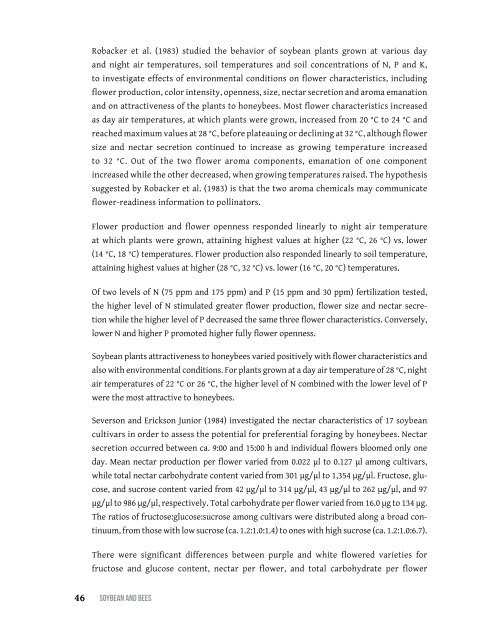Soybean and Bees
You also want an ePaper? Increase the reach of your titles
YUMPU automatically turns print PDFs into web optimized ePapers that Google loves.
Robacker et al. (1983) studied the behavior of soybean plants grown at various day<br />
<strong>and</strong> night air temperatures, soil temperatures <strong>and</strong> soil concentrations of N, P <strong>and</strong> K,<br />
to investigate effects of environmental conditions on flower characteristics, including<br />
flower production, color intensity, openness, size, nectar secretion <strong>and</strong> aroma emanation<br />
<strong>and</strong> on attractiveness of the plants to honeybees. Most flower characteristics increased<br />
as day air temperatures, at which plants were grown, increased from 20 °C to 24 °C <strong>and</strong><br />
reached maximum values at 28 °C, before plateauing or declining at 32 °C, although flower<br />
size <strong>and</strong> nectar secretion continued to increase as growing temperature increased<br />
to 32 °C. Out of the two flower aroma components, emanation of one component<br />
increased while the other decreased, when growing temperatures raised. The hypothesis<br />
suggested by Robacker et al. (1983) is that the two aroma chemicals may communicate<br />
flower-readiness information to pollinators.<br />
Flower production <strong>and</strong> flower openness responded linearly to night air temperature<br />
at which plants were grown, attaining highest values at higher (22 °C, 26 °C) vs. lower<br />
(14 °C, 18 °C) temperatures. Flower production also responded linearly to soil temperature,<br />
attaining highest values at higher (28 °C, 32 °C) vs. lower (16 °C, 20 °C) temperatures.<br />
Of two levels of N (75 ppm <strong>and</strong> 175 ppm) <strong>and</strong> P (15 ppm <strong>and</strong> 30 ppm) fertilization tested,<br />
the higher level of N stimulated greater flower production, flower size <strong>and</strong> nectar secretion<br />
while the higher level of P decreased the same three flower characteristics. Conversely,<br />
lower N <strong>and</strong> higher P promoted higher fully flower openness.<br />
<strong>Soybean</strong> plants attractiveness to honeybees varied positively with flower characteristics <strong>and</strong><br />
also with environmental conditions. For plants grown at a day air temperature of 28 °C, night<br />
air temperatures of 22 °C or 26 °C, the higher level of N combined with the lower level of P<br />
were the most attractive to honeybees.<br />
Severson <strong>and</strong> Erickson Junior (1984) investigated the nectar characteristics of 17 soybean<br />
cultivars in order to assess the potential for preferential foraging by honeybees. Nectar<br />
secretion occurred between ca. 9:00 <strong>and</strong> 15:00 h <strong>and</strong> individual flowers bloomed only one<br />
day. Mean nectar production per flower varied from 0.022 µl to 0.127 µl among cultivars,<br />
while total nectar carbohydrate content varied from 301 µg/µl to 1,354 µg/µl. Fructose, glucose,<br />
<strong>and</strong> sucrose content varied from 42 µg/µl to 314 µg/µl, 43 µg/µl to 262 µg/µl, <strong>and</strong> 97<br />
µg/µl to 986 µg/µl, respectively. Total carbohydrate per flower varied from 16.0 µg to 134 µg.<br />
The ratios of fructose:glucose:sucrose among cultivars were distributed along a broad continuum,<br />
from those with low sucrose (ca. 1.2:1.0:1.4) to ones with high sucrose (ca. 1.2:1.0:6.7).<br />
There were significant differences between purple <strong>and</strong> white flowered varieties for<br />
fructose <strong>and</strong> glucose content, nectar per flower, <strong>and</strong> total carbohydrate per flower<br />
46 SoybeAn <strong>and</strong> bees


